What causes the F99 (Output Over Current Detection) error in Panasonic Air Conditioner?
- Jjudy11Sep 23, 2025
The F99 error code indicates an Output Over Current Detection. This can be caused by a faulty outdoor unit PCB or a faulty compressor.
What causes the F99 (Output Over Current Detection) error in Panasonic Air Conditioner?
The F99 error code indicates an Output Over Current Detection. This can be caused by a faulty outdoor unit PCB or a faulty compressor.
What does H99 error mean on my Panasonic CS-E7NKDW?
The H99 error code on your Panasonic Air Conditioner indicates an indoor freeze prevention protection during cooling or soft dry modes. This can be caused by several factors: an air short circuit at the indoor unit, a clogged air filter, dust accumulation on the heat exchanger, a closed 2/3 way valve, a faulty fan motor, refrigerant shortage (leakage), a clogged expansion valve or strainer, a faulty pipe temperature sensor, or a faulty indoor unit PCB.
What does error code F95 mean on a Panasonic CS-E7NKDW?
The F95 error code indicates a cooling high pressure abnormality. This could be due to an air short circuit at the indoor unit, dust accumulation on the indoor unit heat exchanger, a closed 2/3 way valve, a faulty outdoor unit fan motor, excessive refrigerant, a clogged expansion valve or strainer, a faulty outdoor pipe temperature sensor, or a faulty outdoor unit PCB.
Why does my Panasonic CS-E7NKDW Air Conditioner show H12 (Indoor/Outdoor Capacity Rank Mismatched) error?
The H12 error code on your Panasonic Air Conditioner indicates a capacity rank mismatch between the indoor and outdoor units. This can occur due to wrong models being interconnected, incorrect indoor or outdoor unit PCBs being mounted, defective PCBs, or signal transmission errors caused by incorrect wiring or wire breakage.
What causes the F93 Compressor Rotation Failure in Panasonic CS-E7NKDW Air Conditioner?
The F93 error code indicates a compressor rotation failure. This could be due to a disconnected compressor terminal, a faulty outdoor PCB, or a faulty compressor.
What does H32 error mean on my Panasonic CS-E7NKDW Air Conditioner?
The H32 error code on your Panasonic Air Conditioner indicates an abnormality with the outdoor heat exchanger temperature sensor 2. This can be caused by a faulty connector connection, a faulty sensor, or a faulty PCB.
What does H28 error mean on my Panasonic CS-E7NKDW?
The H28 error code on your Panasonic Air Conditioner indicates an abnormality with the outdoor pipe temperature sensor. This can be caused by a faulty connector connection, a faulty sensor, or a faulty PCB.
What does H27 error mean on my Panasonic Air Conditioner?
The H27 error code on your Panasonic Air Conditioner indicates an abnormality with the outdoor air temperature sensor. This can be caused by a faulty connector connection, a faulty sensor, or a faulty PCB.
What does F11 (4-way valve Abnormality) mean for Panasonic CS-E7NKDW?
The F11 error code indicates a 4-way valve abnormality. This can be caused by a connector in poor contact, a faulty sensor, a faulty outdoor unit PCB, or a defective 4-way valve.
What causes the F97 (Compressor Overheating) error in Panasonic CS-E7NKDW?
The F97 error code indicates compressor overheating. This can be caused by a faulty compressor tank temperature sensor, a closed 2/3 way valve, refrigerant shortage (refrigerant leakage), a faulty outdoor unit PCB, or a faulty compressor.
Locates controls and components on the indoor air conditioning unit.
Locates controls and components on the outdoor air conditioning unit.
Details the layout and functions of the remote control for the air conditioner.
Specifies the detailed dimensions of the indoor unit for different models.
Specifies the detailed dimensions of the outdoor unit for different models.
Illustrates the refrigeration cycle for specific indoor/outdoor unit model combinations.
Shows the overall functional block diagrams for different AC models.
Illustrates the wiring connections for indoor and outdoor units.
Detailed electronic circuit diagrams for indoor and outdoor units.
Layouts of different printed circuit boards for the indoor unit.
Layouts of printed circuit boards for the outdoor unit.
Guidance on choosing optimal locations for indoor and outdoor unit installation.
Detailed steps for installing the indoor air conditioning unit.
Detailed steps for installing the outdoor air conditioning unit.
Overview of basic operational principles and inverter control.
Details manual and auto fan speed settings and operation.
Explains manual and automatic adjustment of vertical and horizontal airflow.
Describes the procedures for enabling and controlling quiet operation in cooling and heating.
Explains Powerful Mode, Timer Control, and Auto Restart functions.
Details the operation, conditions, and indicators for the nanoe-G system.
Explains the function and limitations of the Mild Dry Cooling operation mode.
Covers sensor-based operation for energy saving and comfort.
Thermostat controls for cooling and heating in multi-split configurations.
Decision logic for automatic mode based on environmental factors.
Covers general protection controls like restart and current limits.
Specific protection features for cooling and soft dry modes.
Specific protection features for heating operations.
Explains operations like auto-mode, test run, and remote control modes.
Details functions like setting transmission codes, reset, and display adjustments.
Guidance on diagnosing problems related to the refrigeration system.
How to use the unit's self-diagnosis features to identify errors.
A comprehensive table listing error codes, their causes, and checks.
Step-by-step troubleshooting procedures for specific error codes.
Instructions for removing parts like the front grille, controller, and fan.
Procedures for removing the electronic controller from the outdoor unit.
Graphs showing performance metrics against outdoor air temperature.
Graphs illustrating performance variations based on piping length.
Tables detailing sensible cooling capacity under different conditions.
Exploded views and part numbers for indoor unit components.
Exploded views and part numbers for outdoor unit components.
Locates controls and components on the indoor air conditioning unit.
Locates controls and components on the outdoor air conditioning unit.
Details the layout and functions of the remote control for the air conditioner.
Specifies the detailed dimensions of the indoor unit for different models.
Specifies the detailed dimensions of the outdoor unit for different models.
Illustrates the refrigeration cycle for specific indoor/outdoor unit model combinations.
Shows the overall functional block diagrams for different AC models.
Illustrates the wiring connections for indoor and outdoor units.
Detailed electronic circuit diagrams for indoor and outdoor units.
Layouts of different printed circuit boards for the indoor unit.
Layouts of printed circuit boards for the outdoor unit.
Guidance on choosing optimal locations for indoor and outdoor unit installation.
Detailed steps for installing the indoor air conditioning unit.
Detailed steps for installing the outdoor air conditioning unit.
Overview of basic operational principles and inverter control.
Details manual and auto fan speed settings and operation.
Explains manual and automatic adjustment of vertical and horizontal airflow.
Describes the procedures for enabling and controlling quiet operation in cooling and heating.
Explains Powerful Mode, Timer Control, and Auto Restart functions.
Details the operation, conditions, and indicators for the nanoe-G system.
Explains the function and limitations of the Mild Dry Cooling operation mode.
Covers sensor-based operation for energy saving and comfort.
Thermostat controls for cooling and heating in multi-split configurations.
Decision logic for automatic mode based on environmental factors.
Covers general protection controls like restart and current limits.
Specific protection features for cooling and soft dry modes.
Specific protection features for heating operations.
Explains operations like auto-mode, test run, and remote control modes.
Details functions like setting transmission codes, reset, and display adjustments.
Guidance on diagnosing problems related to the refrigeration system.
How to use the unit's self-diagnosis features to identify errors.
A comprehensive table listing error codes, their causes, and checks.
Step-by-step troubleshooting procedures for specific error codes.
Instructions for removing parts like the front grille, controller, and fan.
Procedures for removing the electronic controller from the outdoor unit.
Graphs showing performance metrics against outdoor air temperature.
Graphs illustrating performance variations based on piping length.
Tables detailing sensible cooling capacity under different conditions.
Exploded views and part numbers for indoor unit components.
Exploded views and part numbers for outdoor unit components.
| Brand | Panasonic |
|---|---|
| Model | CS-E7NKDW |
| Category | Air Conditioner |
| Language | English |
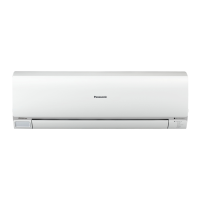
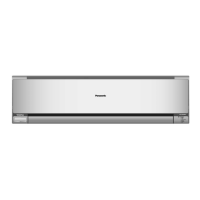
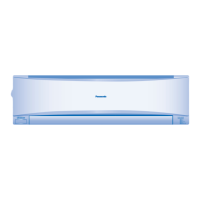

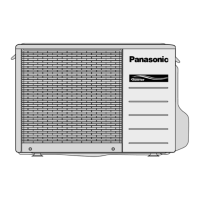
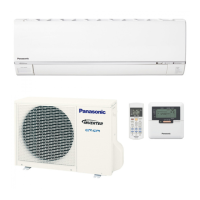

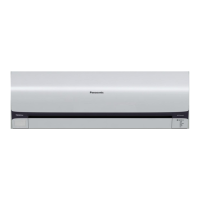

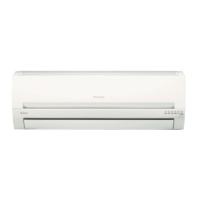
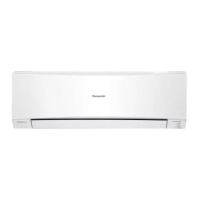

